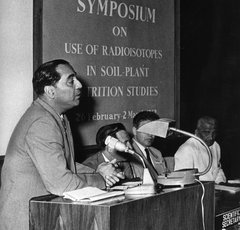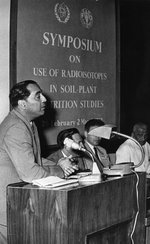Other names
Homi Jehangir Bhabha
Place of birth
Date of arrival to Britain
Location(s)
Trinity Street
Cambridge
CB2 1TA
United Kingdom
Date of time spent in Britain
1927–39
About
Homi Jehangir Bhabha was the son of Jehangir Hormusji Bhabha and Meheran Pandey; his aunt Meherbai was married to Sir Dorab Tata. In 1927 Bhabha went to study engineering at Gonville and Caius College, Cambridge, before being permitted by his father to switch to physics in 1930. Bhabha's main research at Cambridge concerned quantum electrodynamics and, among other things, suggested the existence of heavier electrons.
In 1939, when war broke out, Bhabha was on vacation in India, which made a return to England impossible. He therefore joined the special cosmic ray research unit, created for him by the Sir Dorabji Tata Trust, at the Indian Institute of Science at Bangalore in 1940. He was elected Fellow of the Royal Society in 1941. In June 1945 Bhabha was appointed founder director of the Tata Institute of Fundamental Research. Bhabha's note to the Prime Minister, Jawaharlal Nehru, on the organization of atomic research in India resulted in the setting up of the Atomic Energy Commission of India in August 1948, with Bhabha as its chairman. He presided over the international conference on developing peaceful uses of atomic energy organized by the United Nations in Geneva in 1955.
Bhabha died in an air crash on Mont Blanc on 24 January 1966, on his way to a meeting of the scientific advisory committee of the International Atomic Energy Agency in Vienna.
Jawaharlal Nehru, Dorab Tata.
(with Tata Institute of Fundamental Research and Komaravolu Chandrasekharan) Monographs on Mathematics and Physics (London: Oxford University Press, 1952)
(with Karl J. Khandalavala) Drawings (Bombay: Marg Publications, 1962)
(with Tata Institute of Fundamental Research) Tata Institute of Fundamental Research Studies in Physics (London: Oxford University Press, 1962)
(with Jamshed Bhabha) Homi Bhabha as Artist: A Selection of His Paintings, Drawings, and Sketches (Bombay: Marg Publications, 1968)
Homi Jehangir Bhabha: Collected Scientific Papers (Bombay: Tata Institute of Fundamental Research, 1985)
Anderson, Robert S., Building Scientific Institutions in India: Saha and Bhabha (Montreal: Centre for Developing-Area Studies, 1975)
Cockcroft, John and Menon, M. G. K., Homi Jehangir Bhabha, 1909–1966 (London: The Royal Institution of Great Britain, 1967)
Current Biography (September 1956)
Desmukh, Cintamani, Homi Bhabha (Mumbai: Granthali, 1994)
Electrotechnics [Bangalore] (August 1943)
Kulkarni, R. P. and Sharma, V., Homi Bhabha: Father of Nuclear Science in India (Bombay: Popular Prakashan, 1969)
Lala, R. M., The Heartbeat of a Trust: Fifty Years of the Sir Dorabji Tata Trust (New Delhi: Tata McGraw-Hill, 1984)
Penney, W. G., Biographical Memoirs of Fellows of the Royal Society 13 (1967), pp. 35–55
Physics Today (March 1966), p. 108
Science Reporter [Bhabha number] (October 1966)
Singh, Virendra, 'Bhabha, Homi Jehangir (1909–1966)', Oxford Dictionary of National Biography (Oxford University Press, 2004) [http://www.oxforddnb.com/view/article/51791]
Venkataraman, G., Bhabha and His Magnificent Obsessions (London: Sangam, 1994)
Banner image credit
Thurston Hopkins/Picture Post/Hulton Archives via Getty Images
Image credit
Dr Homi J. Bhabha, Chairman of the Indian Atomic Energy Commission, Bombay, India, 26 February – 2 March 1962
IAEA (via flickr), https://creativecommons.org/licenses/by-sa/2.0/


